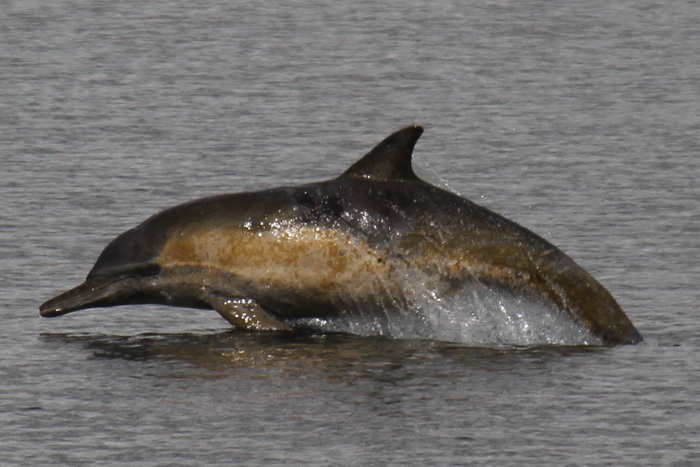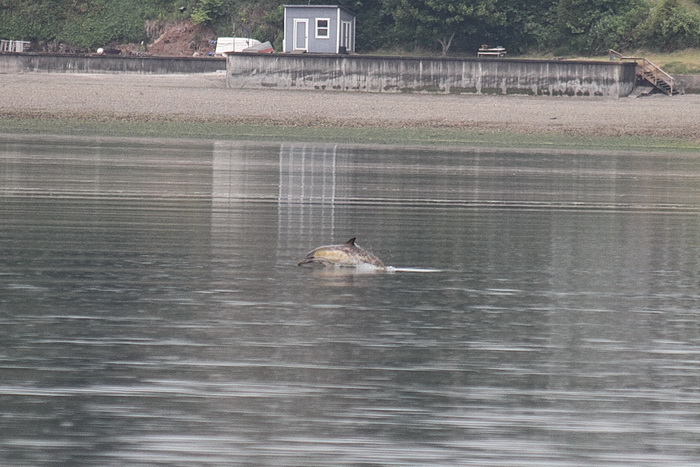
Over the past 18 months south Puget Sound has had some very unusual marine visitors from the tropical waters of southern California and Mexico, the most recent being long-beaked common dolphins. Since 2 June there have been reports of 1-2 dolphins swimming, feeding, and approaching boats along the stretch of shore from Boston Harbor to just south of Burfoot State Park, Olympia. Historically the only other confirmed sighting of this species in Puget Sound was over the summer of 2003 when two long-beaked common dolphins were sighted near Boston Harbor, Dalco Passage and Whidbey Island. Photographs have been obtained by Cascadia and the public that confirm species and that there were/are two animals (one appears to be a juvenile while the other is likely an adult). The current health and survival of these animals is unknown – photographs show one dolphin looking fairly robust, but it also appears that there may be minor skin sloughing and algae growth. Skin sloughing and colonization of atypical microorganisms has been observed in other species of cetaceans when exposed to water with decreased salinity, as is fairly typical in the south part of Puget Sound. Such conditions seem to be reversed quickly if an animal returns to normal ocean salinity levels.
This species of dolphin is typically encountered within 50 nautical miles of the coast from Baja California to about central California. In appearance, they have a distinct black cape that extends into a saddle below their dorsal fin, a light underbelly, and a distinct dark eye to pectoral fin stripe. Their average length is 6-8.5 feet and they can weigh up to 500 lbs. They can be distinguished from harbor porpoise and Dall’s porpoise which are the two species of porpoise commonly encountered in Puget Sound by morphology, pigmentation, shape and behavior. Both porpoise species have fairly triangular dorsal fins, whereas the long-beaked common dolphin has a more “traditional” falcate shaped dorsal fin. Dall’s porpoise are all black with a white patch on their sides, and harbor porpoise are all gray-brown. Neither of the porpoise species expose much more than their back and dorsal fin when they surface, although Dall’s porpoise will often create a noticeable “rooster tail” splash when swimming at top speed. Long-beaked common dolphins often leap out of the water so that much of their bodies are exposed, and they are also more likely to play in the wake of a boat than either of the local porpoise species. Pacific white-sided dolphins commonly found along Washington outer coast are occasionally found in the Straits of Juan de Fuca, they behave similar to the long-beaked common dolphin, however they have a larger dorsal fin and more complicated black, gray and white pigmentation.

Since January 2010 there have been two other subtropical species encountered in southern Puget Sound; two Bryde’s whales (Jan 2010 and Nov-Dec 2010) and two bottlenose dolphins (June 2010 and Nov 2010-January 2011). All four of these animals were reported alive, and then found dead either floating or stranded in south Puget Sound. For further description of these animals please see our stranding page.
Cascadia will continue to monitor the dolphin(s) presence and health in the Puget Sound through sighting reports and photographs. Any sightings, photographs or video of these or other cetaceans are greatly appreciated. If you see these individuals please call our office at (360) 943-7325.
Please view all marine mammals from a distance of 100 yards (200 yards for killer whales in inland waters of WA) or greater, they are protected by the Marine Mammal Protection Act, and it is prohibited to harass, chase, feed or otherwise interfere with them.
For more information on long-beaked common dolphins in the Pacific Northwest see:
Ford, J.K.B. 2005. First records of long-beaked common dolphins, Delphinus capensis, in Canadian waters. Canadian Field-Naturalist 119:110-113.